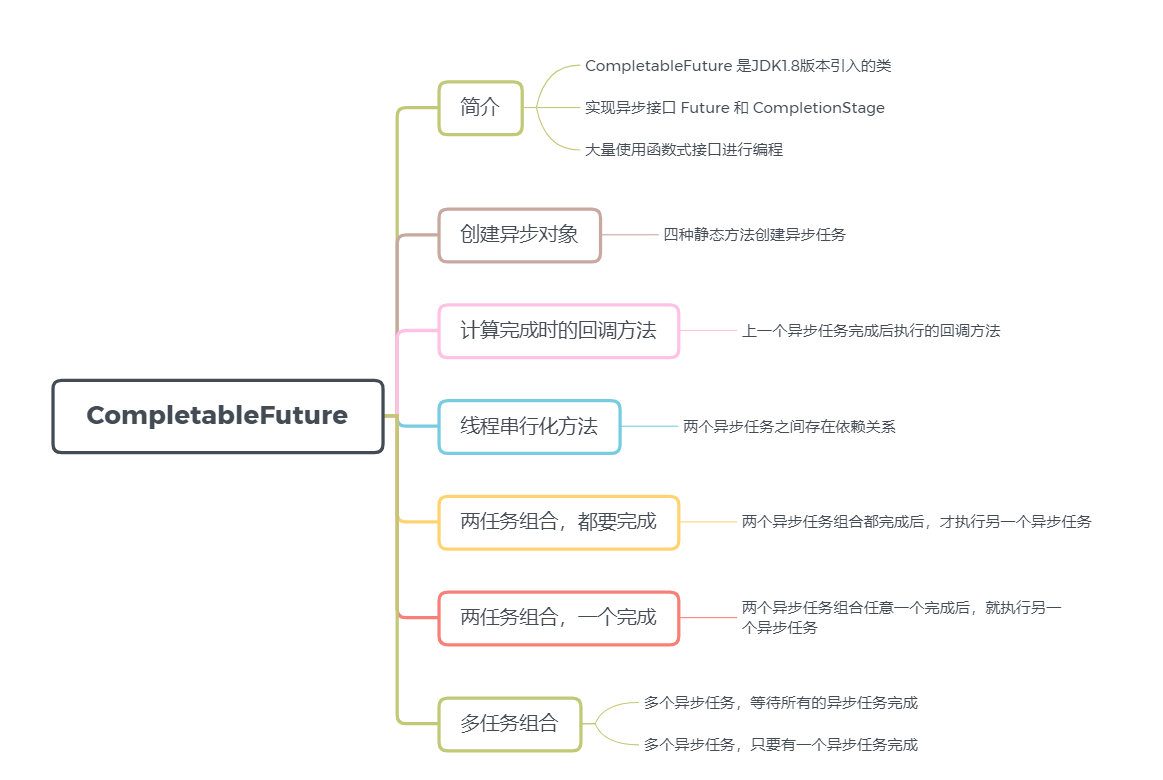CompletableFuture 入门学习
CompletableFuture 是JDK1.8 版本出现的异步编程函数,实现 Future 和 CompletionStage 接口
将从一下几个方面学习 CompletableFuture 并更好的理解并发编程思想

应用场景1:创建异步对象
CompletableFuture 提供了四个静态方法来创建一个异步任务
public static CompletableFuture<Void> runAsync(Runnable runnable);
public static CompletableFuture<Void> runAsync(Runnable runnable, Executor executor);
public static <U> CompletableFuture<U> supplyAsync(Supplier<U> supplier) ;
public static <U> CompletableFuture<U> supplyAsync(Supplier<U> supplier, Executor executor);
1、runXxxx 都是没有返回结果的,supplyXxxx都是可以获取返回结果的
2、提供两个入参的方法可以传入自定义的线程池,否则默认使用公用的ForkJoinPool.commonPool()作为执行异步任务的线程池
示例代码
public static void demo1() throws ExecutionException, InterruptedException {
System.out.println("主线程开始执行。。。");
CompletableFuture<Void> future01 = CompletableFuture.runAsync(() -> System.out.println("无返回值,使用默认线程池"));
System.out.println(future01.get());
CompletableFuture<Void> future02 = CompletableFuture.runAsync(() -> System.out.println("无返回值,使用自定义线程池"), executor);
System.out.println(future02.get());
CompletableFuture<Long> future03 = CompletableFuture.supplyAsync(() -> {
System.out.println("有返回值,使用默认线程池");
return System.currentTimeMillis();
});
System.out.println(future03.get());
CompletableFuture<Long> future04 = CompletableFuture.supplyAsync(() -> {
System.out.println("有返回值,使用自定义线程池");
return System.currentTimeMillis();
}, executor);
System.out.println(future04.get());
System.out.println("主线程结束。。。");
}
应用场景2:异步任务完成时回调方法
当CompletableFuture的计算结果完成,或者抛出异常的时候,可以执行特定的Action。主要是下面的方法:
public CompletableFuture<T> whenComplete(BiConsumer<? super T,? super Throwable> action);
返回相同的结果或例外,这一阶段的新completionstage,这个阶段完成时,执行特定动作的结果(或 null如果没有)和异常(或 null如果没有)这个阶段。
public CompletableFuture<T> whenCompleteAsync(BiConsumer<? super T,? super Throwable> action);
返回相同的结果或例外,这一阶段的新completionstage,这个阶段完成时,执行特定动作执行给定的操作这一阶段的默认的异步执行设施,其结果(或 null如果没有)和异常(或 null如果没有)这个阶段作为参数。
public CompletableFuture<T> whenCompleteAsync(BiConsumer<? super T,? super Throwable> action, Executor executor);
返回相同的结果或例外,这一阶段的新completionstage,这个阶段完成时,执行使用所提供的遗嘱执行人,给出的行动与结果(或 null如果没有)和异常(或 null如果没有)这个阶段作为参数。
public CompletableFuture<T> exceptionally(Function<Throwable,? extends T> fn);
返回一个新的completablefuture已经完成与给定值。
whenComplete 可以处理正常和异常的计算结果,exceptionally 处理异常情况
whenComplete 和 whenCompleteAsync 的区别:
- whenComplete 是执行当前任务的线程继续执行回调任务
- whenCompleteAsync 是把回调任务提交给线程池来继续执行
方法不以 Async 结尾,意味着 Action 使用相同的线程池执行,而 Async 可能会使用其他线程执行(如果是使用相同的线程池,也可能会被同一个线程选中执行)
代码示例
public static void demo2() throws ExecutionException, InterruptedException {
System.out.println("主线程开始执行。。。线程id:" + Thread.currentThread().getId());
CompletableFuture<Long> future01 = CompletableFuture.supplyAsync(() -> {
System.out.println("future01执行,线程id:" + Thread.currentThread().getId());
return System.currentTimeMillis();
}).whenComplete((res, e) -> {
System.out.println("future01回调方法执行 ==》" + res + ",线程id:" + Thread.currentThread().getId());
});
System.out.println(future01.get());
CompletableFuture<Long> future02 = CompletableFuture.supplyAsync(() -> {
System.out.println("future02执行,线程id:" + Thread.currentThread().getId());
return System.currentTimeMillis();
}).whenCompleteAsync((res, e) -> {
System.out.println("future02回调方法执行 ==》" + res + ",线程id:" + Thread.currentThread().getId());
});
System.out.println(future02.get());
CompletableFuture<Long> future03 = CompletableFuture.supplyAsync(() -> {
System.out.println("future03执行,线程id:" + Thread.currentThread().getId());
return System.currentTimeMillis();
}).whenCompleteAsync((res, e) -> {
System.out.println("future03回调方法执行 ==》" + res + ",线程id:" + Thread.currentThread().getId());
}, executor);
System.out.println(future03.get());
CompletableFuture<Long> future04 = CompletableFuture.supplyAsync(() -> {
System.out.println("future04执行,线程id:" + Thread.currentThread().getId());
int i = 10 / 0;
return System.currentTimeMillis();
}).whenCompleteAsync((res, e) -> {
System.out.println("future04回调方法执行 ==》" + res + ",线程id:" + Thread.currentThread().getId());
}, executor).exceptionally((e) -> {
System.out.println("异常回调执行,异常原因:" + e.getMessage() + "==> 线程id:" + Thread.currentThread().getId());
return 0L;
});
System.out.println(future04.get());
System.out.println("主线程结束。。。");
}
应用场景3:线程串行化方法
public <U> CompletableFuture<U> thenApply(Function<? super T,? extends U> fn)
public <U> CompletableFuture<U> thenApplyAsync(Function<? super T,? extends U> fn)
public <U> CompletableFuture<U> thenApplyAsync(Function<? super T,? extends U> fn, Executor executor)
当一个线程依赖另一个线程时,获取上一个任务返回的结果,**并返回当前任务的返回值**。(有返回值)
public CompletionStage<Void> thenAccept(Consumer<? super T> action);
public CompletionStage<Void> thenAcceptAsync(Consumer<? super T> action);
public CompletionStage<Void> thenAcceptAsync(Consumer<? super T> action,Executor executor);
消费处理结果。接收任务的处理结果,并消费处理,**无返回结果。
public CompletionStage<Void> thenRun(Runnable action);
public CompletionStage<Void> thenRunAsync(Runnable action);
public CompletionStage<Void> thenRunAsync(Runnable action,Executor executor);
只要上面的任务执行完成,就开始执行thenRun,**只是处理完任务后,执行 thenRun的后续操作
-
thenApply 方法:当一个线程依赖另一个线程时,获取上一个任务返回的结果,并返回当前任务的返回值。
-
thenAccept方法:消费处理结果。接收任务的处理结果,并消费处理,无返回结果。
-
thenRun方法:只要上面的任务执行完成,就开始执行thenRun,只是处理完任务后,执行 thenRun的后续操作
每一个方法都对应了三种操作。带有Async默认是异步执行的。这里所谓的异步指的是不在当前线程内执行。带有参数Executor executor的则用自定义的线程池,不指定的话则用默认ForkJoinPool.commonPool()线程池
代码示例
public static void demo3() throws ExecutionException, InterruptedException {
System.out.println("主线程开始执行。。。线程id:" + Thread.currentThread().getId());
CompletableFuture<Void> future01 = CompletableFuture.supplyAsync(() -> {
System.out.println("future01执行,线程id:" + Thread.currentThread().getId());
return System.currentTimeMillis();
}).thenRun(() -> {
System.out.println("thenRun执行,无法获取上一步执行结果,无返回值");
});
System.out.println(future01.get());
CompletableFuture<Void> future02 = CompletableFuture.supplyAsync(() -> {
System.out.println("future01执行,线程id:" + Thread.currentThread().getId());
return System.currentTimeMillis();
}).thenAccept((res) -> {
System.out.println("thenAccept,上一步执行结果: " + res +",无返回值");
});
System.out.println(future02.get());
CompletableFuture<Long> future03 = CompletableFuture.supplyAsync(() -> {
System.out.println("future03执行,线程id:" + Thread.currentThread().getId());
return System.currentTimeMillis();
}).thenApply((res) -> {
long i = 10;
System.out.println("thenApply,上一步执行结果: " + res + ",有返回值: " + i);
return i;
});
System.out.println(future03.get());
System.out.println("主线程结束。。。");
}
应用场景4:两任务组合 - 都要完成
public <U,V> CompletableFuture<V> thenCombine(
CompletionStage<? extends U> other,
BiFunction<? super T,? super U,? extends V> fn);
public <U,V> CompletableFuture<V> thenCombineAsync(
CompletionStage<? extends U> other,
BiFunction<? super T,? super U,? extends V> fn);
public <U,V> CompletableFuture<V> thenCombineAsync(
CompletionStage<? extends U> other,
BiFunction<? super T,? super U,? extends V> fn, Executor executor);
组合两个future,获取两个future任务的返回结果,并返回当前任务的返回值
public <U> CompletableFuture<Void> thenAcceptBoth(
CompletionStage<? extends U> other,
BiConsumer<? super T, ? super U> action);
public <U> CompletableFuture<Void> thenAcceptBothAsync(
CompletionStage<? extends U> other,
BiConsumer<? super T, ? super U> action);
public <U> CompletableFuture<Void> thenAcceptBothAsync(
CompletionStage<? extends U> other,
BiConsumer<? super T, ? super U> action, Executor executor);
组合两个future,获取两个future任务的返回结果,然后处理任务,没有返回值。
public CompletableFuture<Void> runAfterBoth(CompletionStage<?> other, Runnable action);
public CompletableFuture<Void> runAfterBothAsync(CompletionStage<?> other, Runnable action);
public CompletableFuture<Void> runAfterBothAsync(CompletionStage<?> other, Runnable action,
Executor executor);
组合两个future,不需要获取future的结果,只需两个future处理完任务后,处理该任务
-
thenCombine:组合两个future,获取两个future任务的返回结果,并返回当前任务的返回值
-
thenAcceptBoth:组合两个future,获取两个future任务的返回结果,然后处理任务,没有返回值。
-
runAfterBoth:组合两个future,不需要获取future的结果,只需两个future处理完任务后,处理该任务
示例代码
public static void demo4() throws ExecutionException, InterruptedException {
System.out.println("主线程开始执行。。。线程id:" + Thread.currentThread().getId());
CompletableFuture<Long> future01 = CompletableFuture.supplyAsync(() -> {
System.out.println("future01执行,线程id:" + Thread.currentThread().getId());
System.out.println("future01结束");
return System.currentTimeMillis();
});
CompletableFuture<Long> future02 = CompletableFuture.supplyAsync(() -> {
System.out.println("future02执行,线程id:" + Thread.currentThread().getId());
try {
Thread.sleep(1000);
} catch (InterruptedException e) {
e.printStackTrace();
}
System.out.println("future02结束");
return System.currentTimeMillis();
});
CompletableFuture<Void> future03 = future01.runAfterBoth(future02, () -> {
System.out.println("任务3开始。。。");
});
CompletableFuture<Void> future04 = future01.thenAcceptBoth(future02, (f1, f2) -> {
System.out.println("任务4开始。。。之前的结果 "+f1+"==>"+f2);
});
CompletableFuture<Long> future05 = future01.thenCombine(future02, (f1, f2) -> {
System.out.println("任务5开始。。。之前的结果 "+f1+"==>"+f2);
return 0L;
});
System.out.println(future05.get());
System.out.println("主线程结束。。。");
}
应用场景5:两任务组合 - 任意一个完成
public <U> CompletableFuture<U> applyToEither(
CompletionStage<? extends T> other, Function<? super T, U> fn);
public <U> CompletableFuture<U> applyToEitherAsync(
CompletionStage<? extends T> other, Function<? super T, U> fn);
public <U> CompletableFuture<U> applyToEitherAsync(
CompletionStage<? extends T> other, Function<? super T, U> fn,Executor executor) ;
组合两个future,只需一个future任务的返回结果,并返回当前任务的返回值
public <U> CompletableFuture<Void> acceptEither(
CompletionStage<? extends U> other,
BiConsumer<? super T, ? super U> action);
public <U> CompletableFuture<Void> acceptEitherAsync(
CompletionStage<? extends U> other,
BiConsumer<? super T, ? super U> action);
public <U> CompletableFuture<Void> acceptEitherAsync(
CompletionStage<? extends U> other,
BiConsumer<? super T, ? super U> action, Executor executor);
组合两个future,只需一个future任务的返回结果,然后处理任务,没有返回值。
public CompletableFuture<Void> runAfterEither(CompletionStage<?> other, Runnable action);
public CompletableFuture<Void> runAfterEitherAsync(CompletionStage<?> other, Runnable action);
public CompletableFuture<Void> runAfterEitherAsync(CompletionStage<?> other, Runnable action,
Executor executor);
组合两个future,不需要获取future的结果,只需一个future处理完任务后,处理该任务
-
applyToEither:组合两个future,只需一个future任务的返回结果,并返回当前任务的返回值
-
acceptEither:组合两个future,只需一个future任务的返回结果,然后处理任务,没有返回值。
-
runAfterEither:组合两个future,不需要获取future的结果,只需一个future处理完任务后,处理该任务
示例代码
public static void demo5() throws ExecutionException, InterruptedException {
System.out.println("主线程开始执行。。。线程id:" + Thread.currentThread().getId());
CompletableFuture<Long> future01 = CompletableFuture.supplyAsync(() -> {
System.out.println("future01执行,线程id:" + Thread.currentThread().getId());
System.out.println("future01结束");
return System.currentTimeMillis();
});
CompletableFuture<Long> future02 = CompletableFuture.supplyAsync(() -> {
System.out.println("future02执行,线程id:" + Thread.currentThread().getId());
try {
Thread.sleep(1000);
} catch (InterruptedException e) {
e.printStackTrace();
}
System.out.println("future02结束");
return System.currentTimeMillis();
});
CompletableFuture<Void> future03 = future01.runAfterEither(future02, () -> {
System.out.println("任务3开始。。。");
});
CompletableFuture<Void> future04 = future01.acceptEither(future02, (res) -> {
System.out.println("任务4开始。。。之前的结果 "+res);
});
CompletableFuture<Long> future05 = future01.applyToEither(future02, (res) -> {
System.out.println("任务5开始。。。之前的结果 "+res);
return 0L;
});
System.out.println(future05.get());
System.out.println("主线程结束。。。");
}
应用场景6:多任务组合
public static CompletableFuture<Void> allOf(CompletableFuture<?>... cfs);
public static CompletableFuture<Object> anyOf(CompletableFuture<?>... cfs);
-
allOf:等待所有任务完成
-
anyOf:只要有一个任务完成,并返回执行结果
代码示例
public static void demo6() throws ExecutionException, InterruptedException {
System.out.println("主线程开始执行。。。线程id:" + Thread.currentThread().getId());
CompletableFuture<Long> future01 = CompletableFuture.supplyAsync(() -> {
System.out.println("future01执行,线程id:" + Thread.currentThread().getId());
System.out.println("future01结束");
return System.currentTimeMillis();
});
CompletableFuture<Long> future02 = CompletableFuture.supplyAsync(() -> {
System.out.println("future02执行,线程id:" + Thread.currentThread().getId());
try {
Thread.sleep(1000);
} catch (InterruptedException e) {
e.printStackTrace();
}
System.out.println("future02结束");
return System.currentTimeMillis();
});
CompletableFuture<Void> future03 = CompletableFuture.allOf(future01, future02);
CompletableFuture<Object> future04 = CompletableFuture.anyOf(future01, future02);
System.out.println("anyOf 任意一个异步任务执行完成"+future04.get());
System.out.println("allOf 等待所有异步任务执行完成"+future03.get());
System.out.println("主线程结束。。。");
}
完整案例代码:

